Long-Range Plume Transport from Brazilian Burnings to Urban São Paulo: A Remote Sensing Analysis
Abstract
1. Introduction
2. Materials and Methods
2.1. Study Area and Data
2.2. Instrumentation
2.2.1. The SPU Lidar Station
2.2.2. Atmospheric Lidar (ATLID) Instrument Onboard EarthCARE
2.2.3. Hybrid Single-Particle Lagrangian Integrated Trajectory Model (HYSPLIT)
2.2.4. Aerosol Robotic Network (AERONET)
3. Methodology
3.1. EarthCARE and ATLID Data
3.2. SPU Lidar Station Data
3.3. AERONET and Ångström Matrix
3.4. BDQueimadas Data
4. Results and Discussion
4.1. Comparison Between ATLID and SPU Lidar Station Data
4.2. Analysis of Atmospheric Transport to São Paulo
4.2.1. SPU Lidar Station Measurements
4.2.2. Ångström Matrix for São Paulo
4.2.3. BDQueimadas Data Analysis
4.2.4. HYSPLIT Analysis
4.2.5. EarthCARE Data for Corumbá and São Félix do Xingu
5. Conclusions
Author Contributions
Funding
Institutional Review Board Statement
Informed Consent Statement
Data Availability Statement
Acknowledgments
Conflicts of Interest
References
- Pivello, V.R. The Use of Fire in the Cerrado and Amazonian Rainforests of Brazil: Past and Present. Fire Ecol. 2011, 7, 24–39. [Google Scholar] [CrossRef]
- Rosário, N.É.D.; Sena, E.T.; Yamasoe, M.A. South American 2020 Regional Smoke Plume: Intercomparison with Previous Years, Impact on Solar Radiation, and the Role of Pantanal Biomass Burning Season. Atmos. Chem. Phys. 2022, 22, 15021–15033. [Google Scholar] [CrossRef]
- Moreira, D.S.; Longo, K.M.; Freitas, S.R.; Yamasoe, M.A.; Mercado, L.M.; Rosário, N.E.; Gloor, E.; Viana, R.S.M.; Miller, J.B.; Gatti, L.V.; et al. Modeling the radiative effects of biomass burning aerosols on carbon fluxes in the Amazon region. Atmos. Chem. Phys. 2017, 17, 14785–14810. [Google Scholar] [CrossRef]
- Thornhill, G.D.; Ryder, C.L.; Highwood, E.J.; Shaffrey, L.C.; Johnson, B.T. The effect of South American biomass burning aerosol emissions on the regional climate. Atmos. Chem. Phys. 2018, 18, 5321–5342. [Google Scholar] [CrossRef]
- World Health Organization; United Nations Children’s Fund (UNICEF); United Nations Development Programme; United Nations Environment Programme. Compendium of WHO and Other UN Guidance in Health and Environment, 2024 Update; World Health Organization: Geneva, Switzerland, 2024. Available online: https://iris.who.int/handle/10665/378095 (accessed on 20 August 2025).
- Correia, A.L.; Sena, E.T.; Silva Dias, M.A.F.; Koren, I. Preconditioning, aerosols, and radiation control the temperature of glaciation in Amazonian clouds. Commun. Earth Environ. 2021, 2, 168. [Google Scholar] [CrossRef]
- Feng, X.; Mickley, L.J.; Bell, M.L.; Liu, T.; Fisher, J.A.; Val Martin, M. Improved estimates of smoke exposure during Australia fire seasons: Importance of quantifying plume injection heights. Atmos. Chem. Phys. 2024, 24, 2985–3007. [Google Scholar] [CrossRef]
- Val Martin, M.; Kahn, R.A.; Tosca, M.G. A Global Analysis of Wildfire Smoke Injection Heights Derived from Space-Based Multi-Angle Imaging. Remote Sens. 2018, 10, 1609. [Google Scholar] [CrossRef]
- Stull, R.B. Practical Meteorology: An Algebra-Based Survey of Atmospheric Science; University of British Columbia: Vancouver, BC, Canada, 2017. Available online: https://www.eoas.ubc.ca/books/Practical_Meteorology/ (accessed on 7 July 2025).
- Rudke, A.P.; Martins, L.D.; Martins, J.A.; Mantoani, M.C.; Andrade, M.F.; Kumar, P.; Alves, R.A.; Pedruzzi, R.; Thompson, T.; Sobrinho, O.M.; et al. Where there is smoke, there is fire: Long- and mid-range biomass burning role on São Paulo’s state air quality. Environ. Pollut. 2025, 384, 126993. [Google Scholar] [CrossRef]
- Rogers, H.M.; Ditto, J.C.; Gentner, D.R. Evidence for impacts on surface-level air quality in the northeastern US from long-distance transport of smoke from North American fires during the Long Island Sound Tropospheric Ozone Study (LISTOS) 2018. Atmos. Chem. Phys. 2020, 20, 671–682. [Google Scholar] [CrossRef]
- Moreira, G.A.; Carbone, S.; Guerrero-Rascado, J.L.; Andrade, I.S.; Cacheffo, A.; Vélez-Pereira, A.M.; Zamora-Ledezma, E.; Thielen, D.; Gomes, A.A.; Duarte, E.S.F.; et al. Evidence of the Consequences of the Prolonged Fire Season on Air Quality and Public Health from 2024 São Paulo (Brazil) Data. Sci. Rep. 2025, 15, 28337. [Google Scholar] [CrossRef]
- Instituto Nacional de Pesquisas Espaciais (INPE). Programa Queimadas: Monitoramento de Focos Ativos por Satélite. BDQueimadas. São José dos Campos, São Paulo, Brazil. Available online: https://terrabrasilis.dpi.inpe.br/queimadas/bdqueimadas/ (accessed on 4 March 2025). (In Portuguese).
- Andrade, M.F.; Kumar, P.; Freitas, E.D.; Ynoue, R.Y.; Martins, J.; Martins, L.D.; Nogueira, T.; Perez-Martinez, P.; Miranda, R.M.; Albuquerque, T.; et al. Air quality in the megacity of São Paulo: Evolution over the last 30 years and future perspectives. Atmos. Environ. 2017, 159, 66–82. [Google Scholar] [CrossRef]
- Pereira, G.M.; Kamigauti, L.Y.; Pereira, R.F.; Santos, D.M.; Santos, T.S.; Martins, J.V.; Alves, C.; Gonçalves, C.; Rienda, I.C.; Kováts, N.; et al. Source apportionment and ecotoxicity of PM2.5 pollution events in a major Southern Hemisphere megacity: Influence of a biofuel-impacted fleet and biomass burning. Atmos. Chem. Phys. 2025, 25, 4587–4616. [Google Scholar] [CrossRef]
- Adetona, O.; Reinhardt, T.E.; Domitrovich, J.; Broyles, G.; Adetona, A.M.; Kleinman, M.T.; Ottmar, R.D.; Naeher, L.P. Review of the health effects of wildland fire smoke on wildland firefighters and the public. Inhal. Toxicol. 2016, 28, 95–139. [Google Scholar] [CrossRef]
- DeFlorio-Barker, S.; Crooks, J.; Reyes, J.; Rappold, A.G. Cardiopulmonary effects of fine particulate matter exposure among older adults, during wildfire and non-wildfire periods, in the United States, 2008–2010. Environ. Health Perspect. 2019, 127, 37006. [Google Scholar] [CrossRef]
- Moreira, G.A.; Andrade, I.S.; Cacheffo, A.; Lopes, F.J.S.; Yoshida, A.C.; Gomes, A.A.; da Silva, J.J.; Landulfo, E. Influence of a biomass-burning event in PM2.5 concentration and air quality: A case study in the metropolitan area of São Paulo. Sensors 2021, 21, 425. [Google Scholar] [CrossRef]
- Brazilian Institute of Geography and Statistics (IBGE). Cidades e Estados: São Paulo, São Félix do Xingu e Corumbá—Panorama do Censo 2022. Available online: https://www.ibge.gov.br/pt/inicio.html (accessed on 4 March 2025).
- Alvares, C.A.; Stape, J.L.; Sentelhas, P.C.; de Moraes Gonçalves, J.L.; Sparovek, G. Köppen’s Climate Classification Map for Brazil. Meteorol. Z. 2013, 22, 711–728. [Google Scholar] [CrossRef]
- Sant’Anna Neto, J.L.; Galvani, E.; Vieira, B.C. Climates of Brazil: Past and Present. In Landscapes and Landforms of Brazil; Vieira, B., Salgado, A., Santos, L., Eds.; World Geomorphological Landscapes; Springer: Dordrecht, The Netherlands, 2015; pp. 29–38. [Google Scholar] [CrossRef]
- Antuña, J.C.; Landulfo, E.; Estevan, R.; Barja, B.; Robock, A.; Wolfram, E.; Ristori, P.; Clemesha, B.; Zaratti, F.; Forno, R.; et al. LALINET: The First Latin American–Born Regional Atmospheric Observational Network. Bull. Am. Meteor. Soc. 2017, 98, 1255–1275. [Google Scholar] [CrossRef]
- Wehr, T.; Kubota, T.; Tzeremes, G.; Wallace, K.; Nakatsuka, H.; Ohno, Y.; Koopman, R.; Rusli, S.; Kikuchi, M.; Eisinger, M.; et al. The EarthCARE mission—Science and system overview. Atmos. Meas. Tech. 2023, 16, 3581–3608. [Google Scholar] [CrossRef]
- Donovan, D.P.; van Zadelhoff, G.-J.; Wang, P. The EarthCARE lidar cloud and aerosol profile processor (A-PRO): The A-AER, A-EBD, A-TC, and A-ICE products. Atmos. Meas. Tech. 2024, 17, 5301–5340. [Google Scholar] [CrossRef]
- Nishizawa, T.; Kudo, R.; Oikawa, E.; Higurashi, A.; Jin, Y.; Sugimoto, N.; Sato, K.; Okamoto, H. Algorithm to Retrieve Aerosol Optical Properties Using Lidar Measurements on Board the EarthCARE Satellite. Atmos. Meas. Tech. Discuss. 2024, 2024, 1–24. [Google Scholar] [CrossRef]
- Draxler, R.R.; Hess, G.D. An overview of the HYSPLIT-4 modelling system for trajectories, dispersion, and deposition. Atmos. Meas. Tech. 1998, 47, 295–308. [Google Scholar]
- Holben, B.N.; Eck, T.F.; Slutsker, I.; Tanré, D.; Buis, J.P.; Setzer, A.; Vermote, E.; Reagan, J.A.; Kaufman, Y.J.; Nakajima, T.; et al. AERONET—A Federated Instrument Network and Data Archive for Aerosol Characterization. Remote Sens. Environ. 1998, 66, 1–16. [Google Scholar] [CrossRef]
- European Space Agency (ESA). EarthCARE Online Dissemination Service—Online Collections. Available online: https://ec-pdgs-dissemination2.eo.esa.int/oads/access/collection (accessed on 10 July 2025).
- European Space Agency (ESA). Earth System Orbit Visualization (ESOV) Software User Manual. Available online: https://eop-cfi.esa.int/index.php/applications/esov (accessed on 16 April 2025).
- Amiridis, V.; Marinou, E.; Hostetler, C.; Koopman, R.; Cecil, D.; Moisseev, D.; Tackett, J.; Groß, S.; Baars, H.; Redemann, J.; et al. Best Practice Protocol for the validation of Aerosol, Cloud, and Precipitation Profiles (ACPPV) (Version 2). Zenodo 2025. [Google Scholar] [CrossRef]
- Eisinger, M.; Marnas, F.; Wallace, K.; Kubota, T.; Tomiyama, N.; Ohno, Y.; Tanaka, T.; Tomita, E.; Wehr, T.; Bernaerts, D. The EarthCARE mission: Science data processing chain overview. Atmos. Meas. Tech. 2024, 17, 839–862. [Google Scholar] [CrossRef]
- Weitkamp, C. (Ed.) Lidar: Range-Resolved Optical Remote Sensing of the Atmosphere; Springer Series in Optical Sciences; Springer: New York, NY, USA, 2005; ISBN 978-0-387-40075-4. [Google Scholar] [CrossRef]
- Klett, J.D. Lidar inversion with variable backscatter/extinction ratios. Appl. Opt. 1985, 24, 1638–1643. [Google Scholar] [CrossRef]
- Fernald, F.G. Analysis of Atmospheric Lidar Observations: Some Comments. Appl. Opt. 1984, 23, 652–653. [Google Scholar] [CrossRef] [PubMed]
- Sasano, Y.; Browell, E.V. Light Scattering Characteristics of Various Aerosol Types Derived from Multiple Wavelength Lidar Observations. Appl. Opt. 1989, 28, 1670–1679. [Google Scholar] [CrossRef]
- Jesus, E.O. Classificação de Aerossóis na América do Sul Utilizando a Rede de Fotômetros Solares AERONET—Preparação para uma Metodologia de Validação do Satélite EarthCARE—ESA. Available online: https://repositorio.unifesp.br/handle/11600/65371 (accessed on 20 August 2025). (In Portuguese).
- Jin, J.; Henzing, B.; Segers, A. How aerosol size matters in aerosol optical depth (AOD) assimilation and the optimization using the Ångström exponent. Atmos. Chem. Phys. 2023, 23, 1641–1660. [Google Scholar] [CrossRef]
- Bergstrom, R.W.; Russell, P.B.; Hignett, P. Wavelength dependence of the absorption of black carbon particles: Predictions and results from the TARFOX experiment and implications for the aerosol single scattering albedo. J. Atmos. Sci. 2002, 59, 567–577. [Google Scholar] [CrossRef]
- Kim, M.; Kim, S.H.; Kim, W.V.; Lee, Y.G.; Kim, J.; Kafatos, M.C. Assessment of Aerosol optical depth under background and polluted conditions using AERONET and VIIRS datasets. Atmos. Environ. 2021, 245, 117994. [Google Scholar] [CrossRef]
- Cazorla, A.; Bahadur, R.; Suski, K.J.; Cahill, J.F.; Chand, D.; Schmid, B.; Ramanathan, V.; Prather, K.A. Relating aerosol absorption due to soot, organic carbon, and dust to emission sources determined from in situ chemical measurements. Atmos. Chem. Phys. 2013, 13, 9337–9350. [Google Scholar] [CrossRef]
- Romano, S.; Perrone, M.R.; Pavese, G.; Esposito, F.; Calvello, M. Optical properties of PM2.5 particles: Results from a monitoring campaign in southeastern Italy. Atmos. Environ. 2019, 203, 35–47. [Google Scholar] [CrossRef]
- Cappa, C.D.; Kolesar, K.R.; Zhang, X.; Atkinson, D.B.; Pekour, M.S.; Zaveri, R.A.; Zelenyuk, A.; Zhang, Q. Understanding the optical properties of ambient sub- and supermicron particulate matter: Results from the CARES 2010 field study in northern California. Atmos. Chem. Phys. 2016, 16, 6511–6535. [Google Scholar] [CrossRef]
- Moosmüller, H.; Chakrabarty, R.K. Technical Note: Simple analytical relationships between Ångström coefficients of aerosol extinction, scattering, absorption, and single scattering albedo. Atmos. Chem. Phys. 2011, 11, 10677–10680. [Google Scholar] [CrossRef]
- Morais, F.G.; Franco, M.A.; Palácios, R.; Machado, L.A.T.; Rizzo, L.V.; Barbosa, H.M.J.; Jorge, F.; Schafer, J.S.; Holben, B.N.; Landulfo, E.; et al. Relationship between Land Use and Spatial Variability of Atmospheric Brown Carbon and Black Carbon Aerosols in Amazonia. Atmosphere 2022, 13, 1328. [Google Scholar] [CrossRef]
- Mariano, G.L.; Lopes, F.J.S.; Jorge, M.P.P.M.; Landulfo, E. Assessment of biomass burnings activity with the synergy of sunphotometric and LIDAR measurements in São Paulo, Brazil. Atmos. Res. 2010, 98, 486–499. [Google Scholar] [CrossRef]
- Gonzalez-Alonso, L.; Val Martin, M.; Kahn, R.A. Biomass-Burning Smoke Heights over the Amazon Observed from Space. Atmos. Chem. Phys. 2019, 19, 1685–1702. [Google Scholar] [CrossRef]
- Wandinger, U.; Floutsi, A.A.; Baars, H.; Haarig, M.; Ansmann, A.; Hünerbein, A.; Docter, N.; Donovan, D.; van Zadelhoff, G.-J.; Mason, S.; et al. HETEAC—The Hybrid End-to-End Aerosol Classification Model for EarthCARE. Atmos. Meas. Tech. 2023, 16, 2485–2510. [Google Scholar] [CrossRef]
- Nepomuceno Pereira, S.; Preißler, J.; Guerrero-Rascado, J.L.; Silva, A.M.; Wagner, F. Forest Fire Smoke Layers Observed in the Free Troposphere over Portugal with a Multiwavelength Raman Lidar: Optical and Microphysical Properties. Sci. World J. 2014, 2014, 421838. [Google Scholar] [CrossRef] [PubMed]
- Irbah, A.; Delanoë, J.; van Zadelhoff, G.-J.; Donovan, D.P.; Kollias, P.; Puigdomènech Treserras, B.; Mason, S.; Hogan, R.J.; Tatarevic, A. The Classification of Atmospheric Hydrometeors and Aerosols from the EarthCARE Radar and Lidar: The A-TC, C-TC, and AC-TC Products. Atmos. Meas. Tech. 2023, 16, 2795–2820. [Google Scholar] [CrossRef]
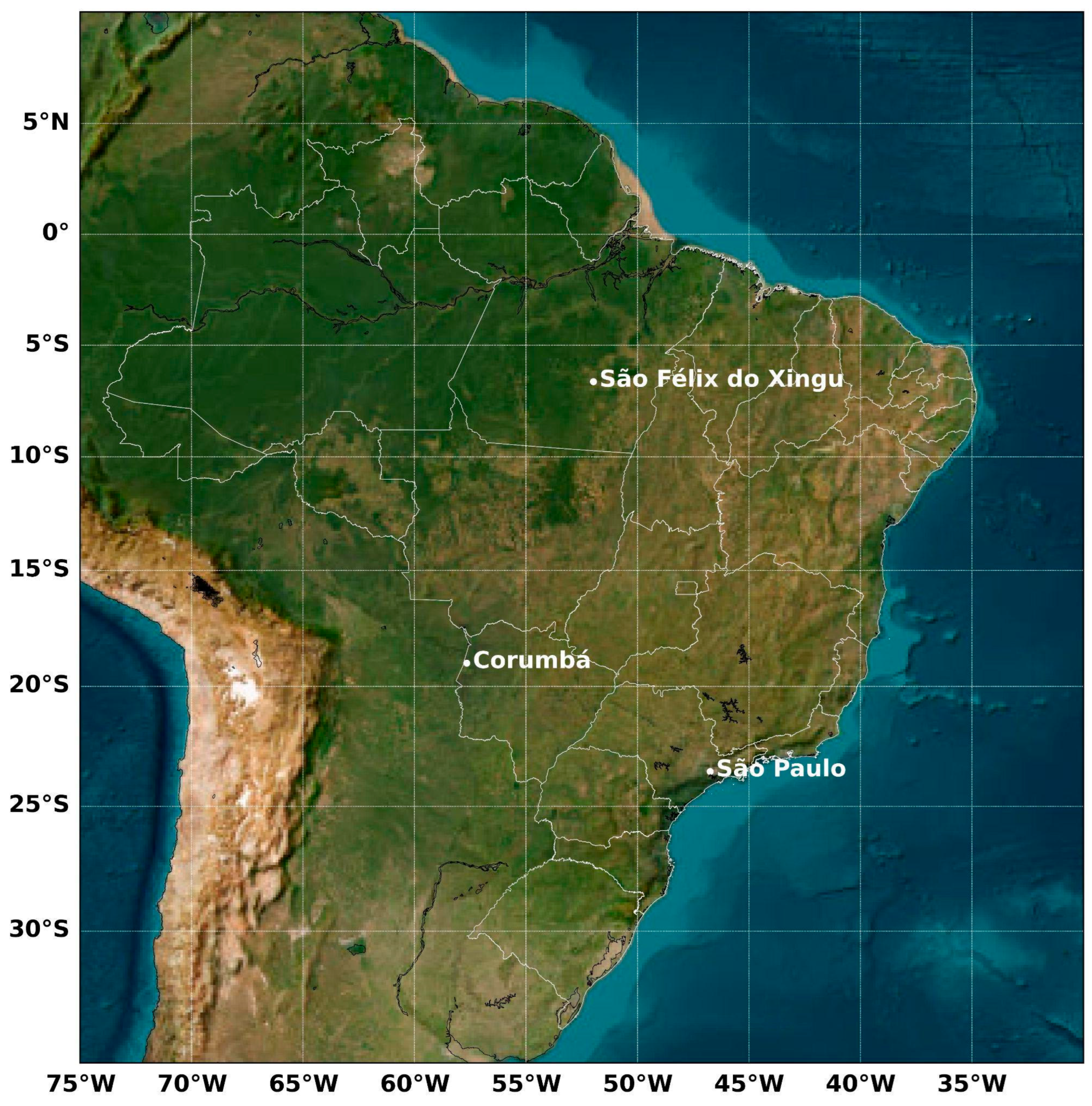

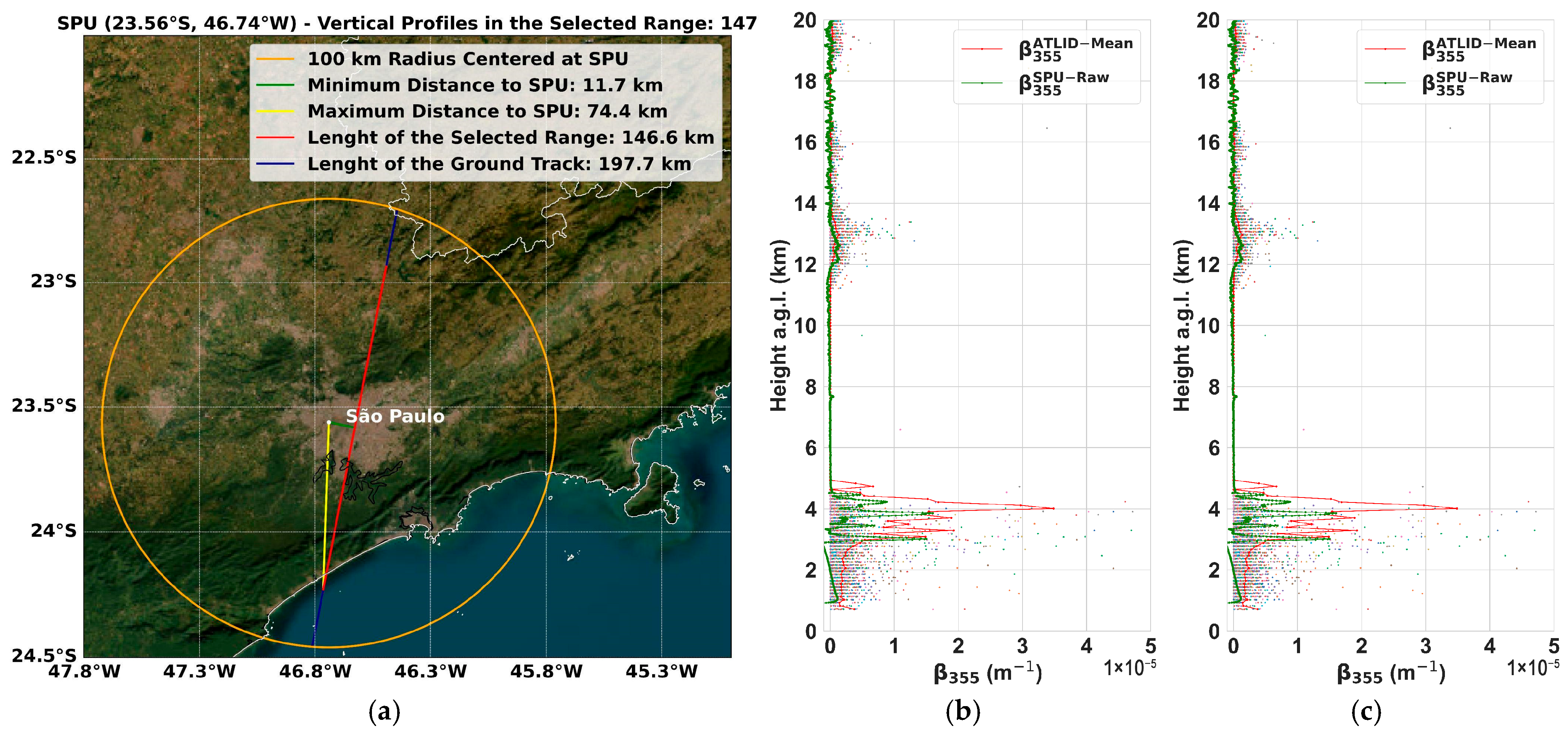
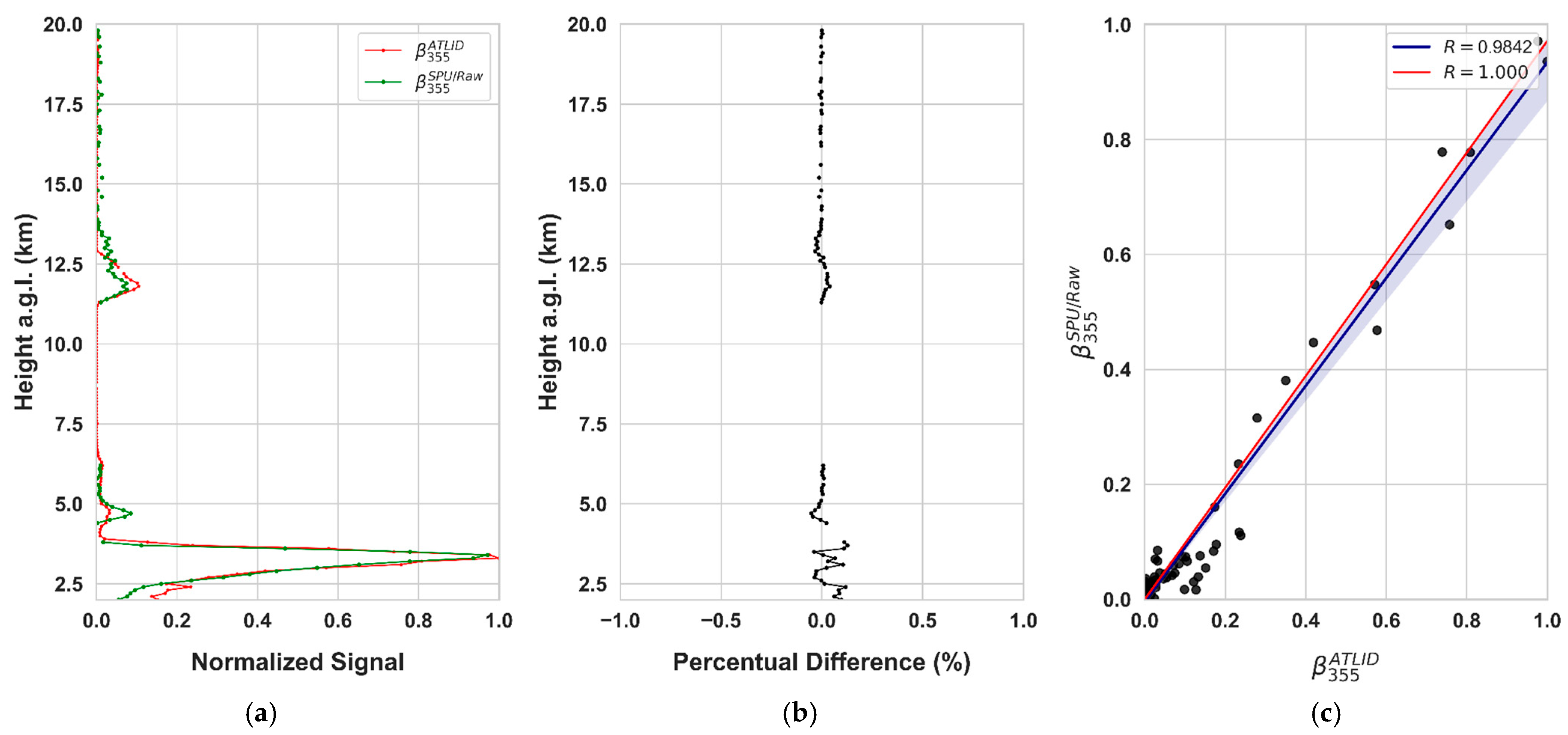
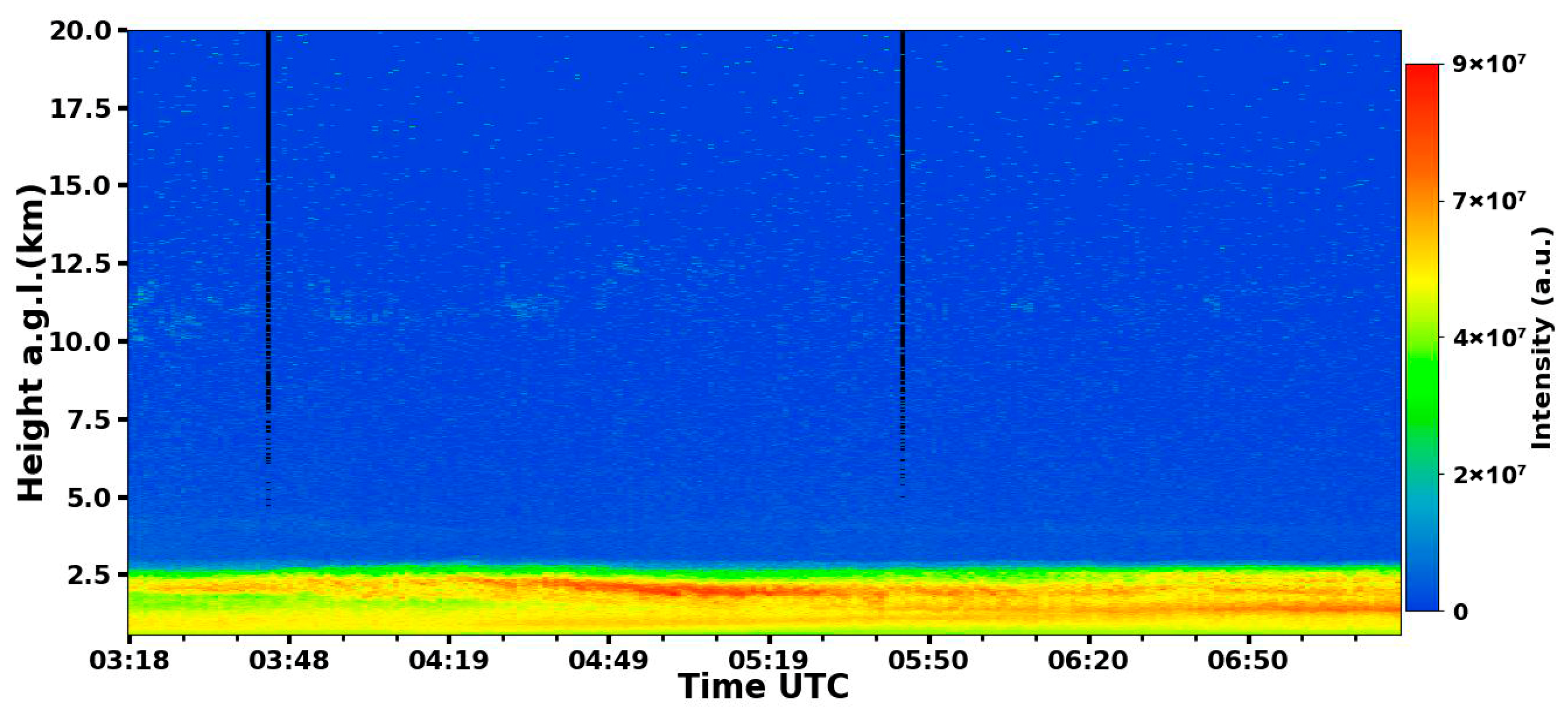
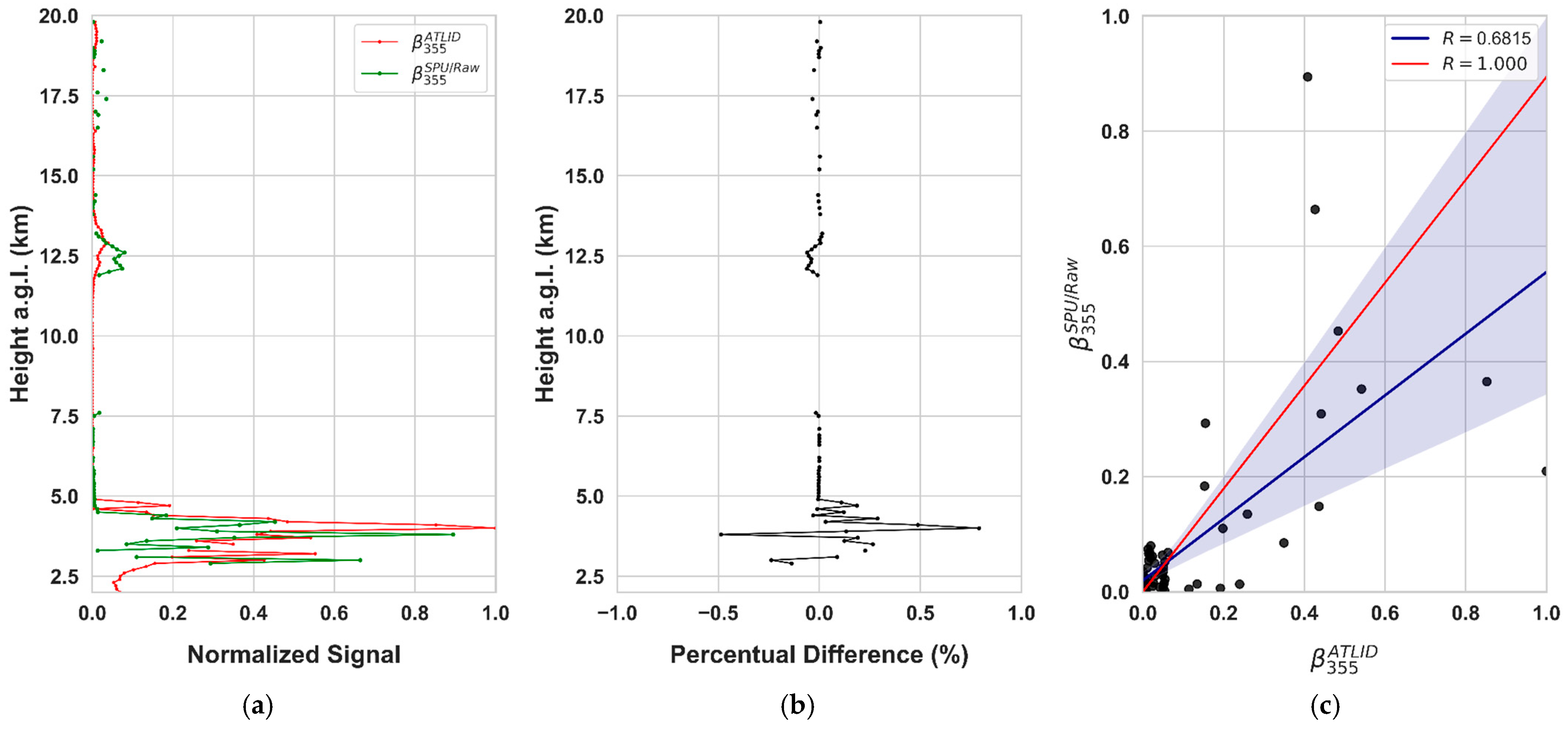
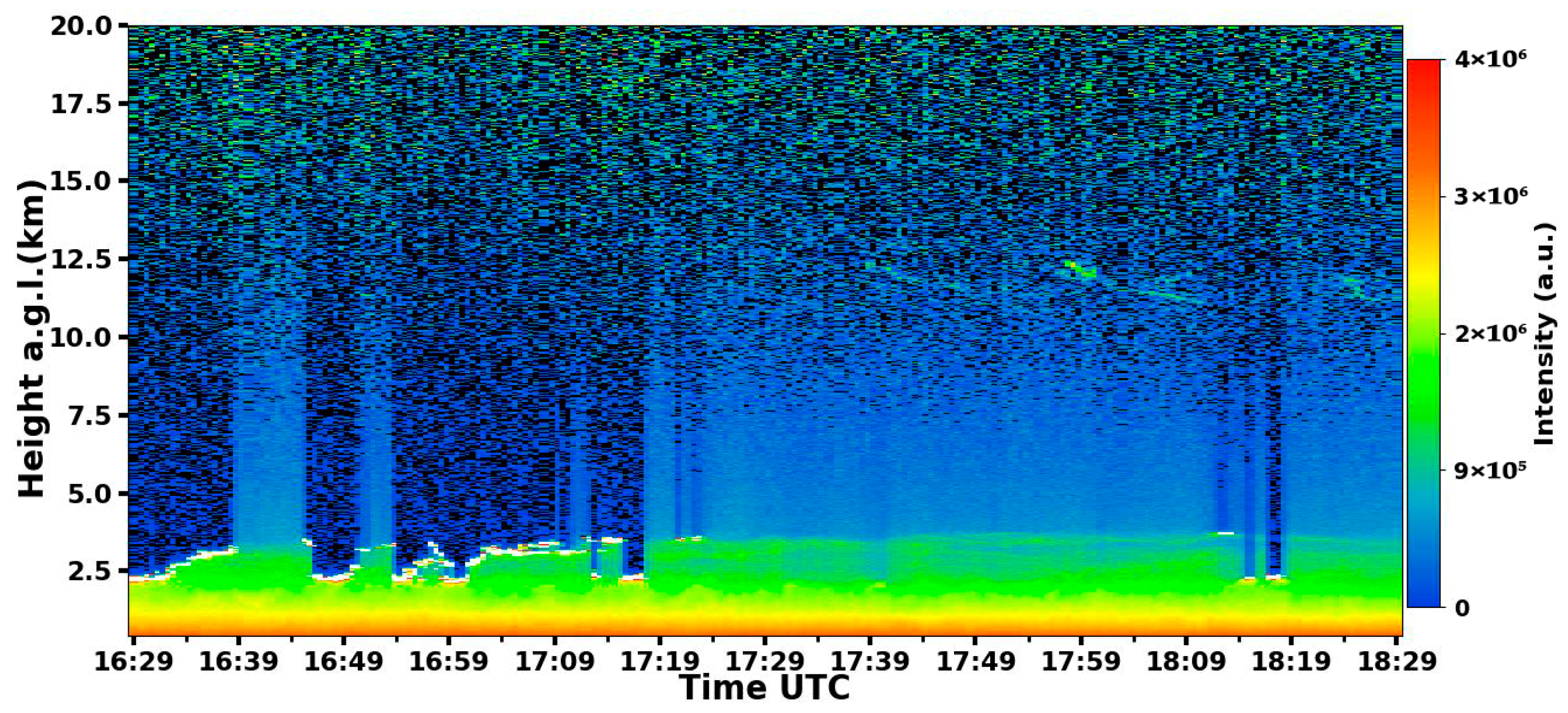
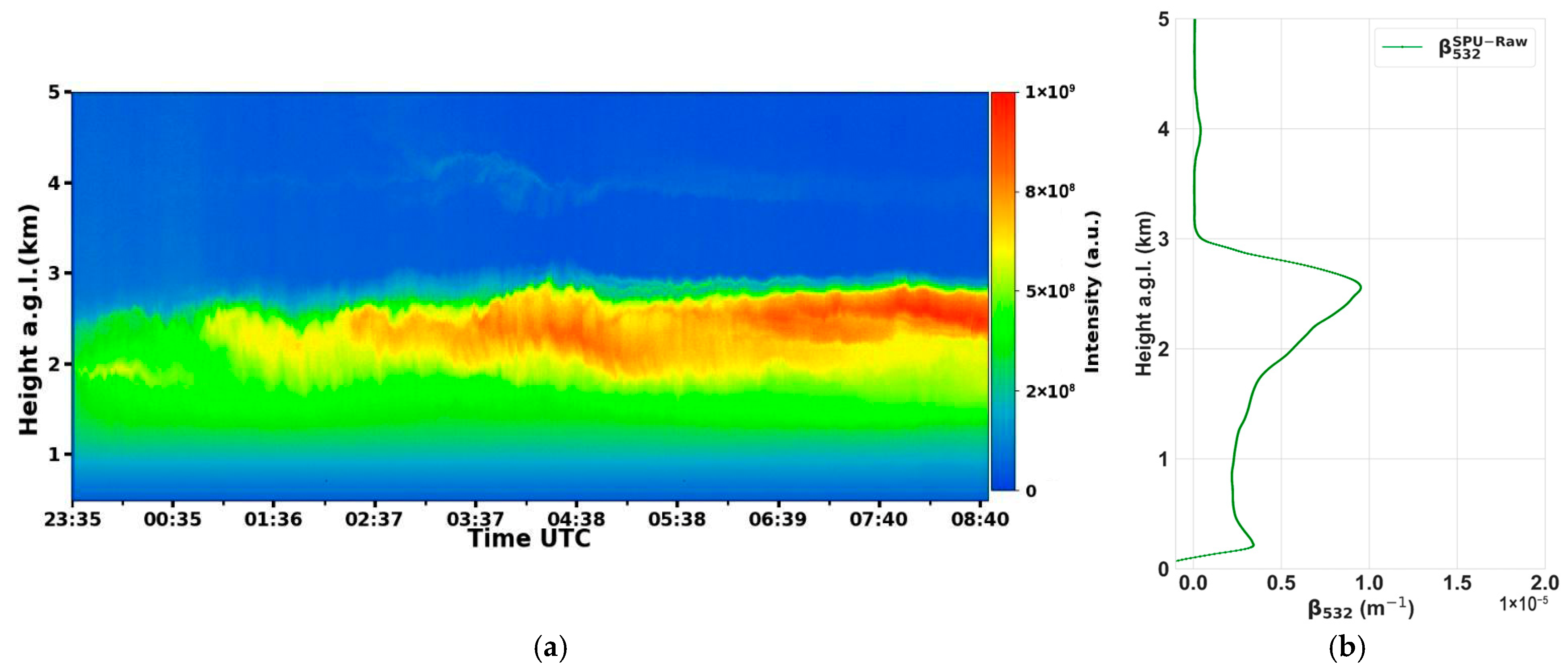
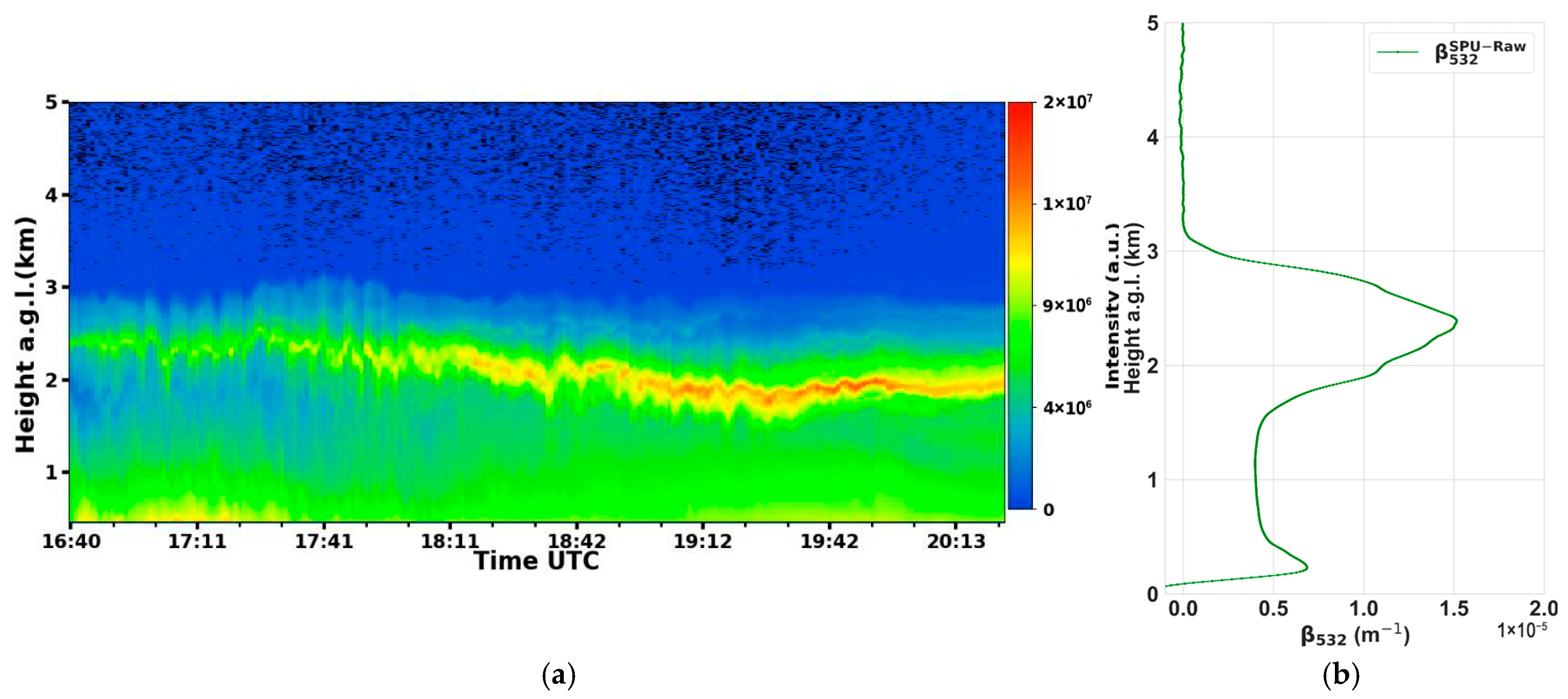


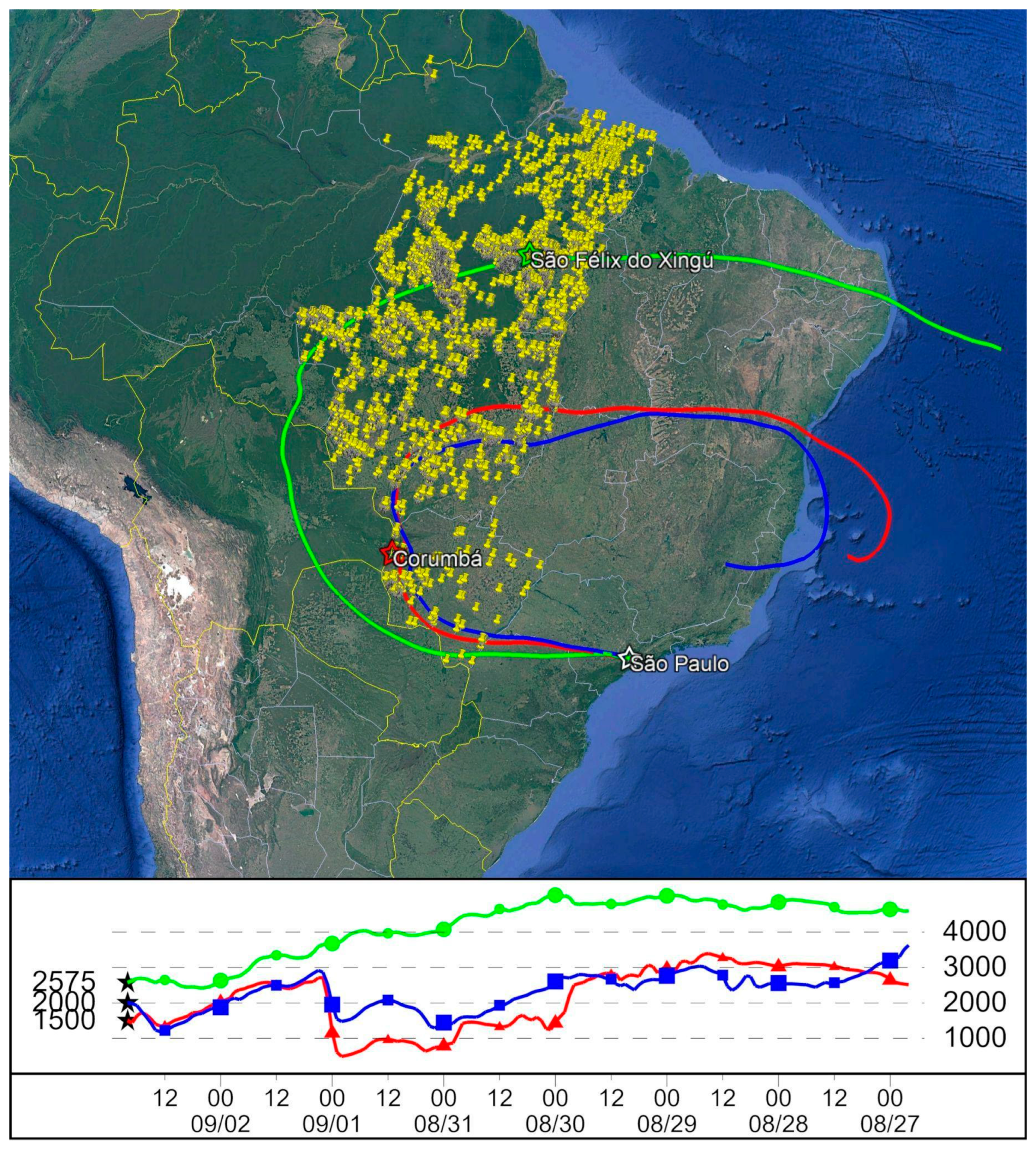


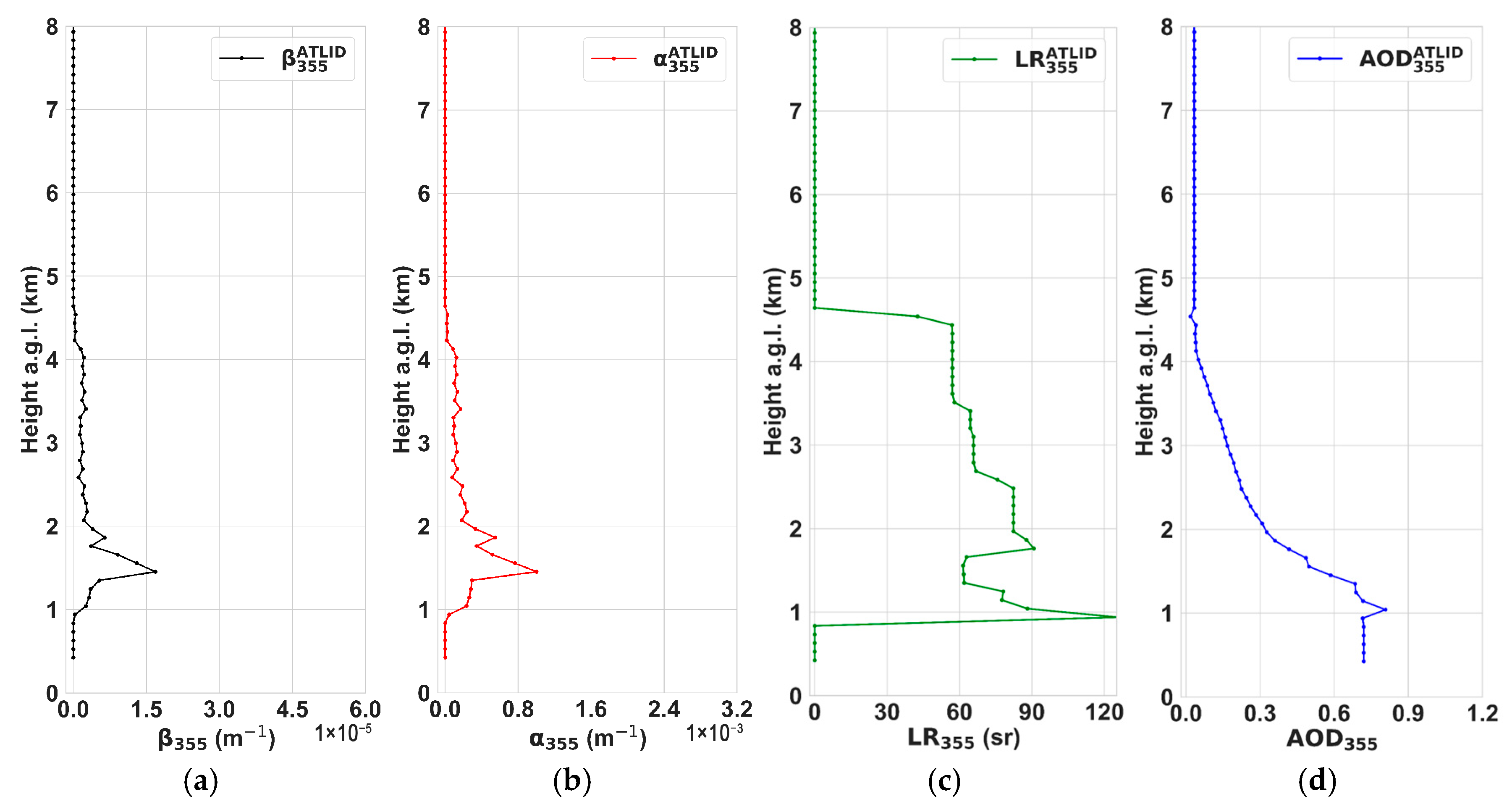

| Corumbá | São Félix do Xingu | São Paulo | |
|---|---|---|---|
| Start Orbit | 1412 | 1443 | 1497 |
| Start Sec | 3054 | 2865 | 5187 |
| Start Date | 27 August 2024 | 29 August 2024 | 2 September 2024 |
| Start UTC | ~T17:41:32 | ~T17:27:18 | ~T05:17:14 |
Disclaimer/Publisher’s Note: The statements, opinions and data contained in all publications are solely those of the individual author(s) and contributor(s) and not of MDPI and/or the editor(s). MDPI and/or the editor(s) disclaim responsibility for any injury to people or property resulting from any ideas, methods, instructions or products referred to in the content. |
© 2025 by the authors. Licensee MDPI, Basel, Switzerland. This article is an open access article distributed under the terms and conditions of the Creative Commons Attribution (CC BY) license (https://creativecommons.org/licenses/by/4.0/).
Share and Cite
Silva, G.M.d.; Rodrigues, M.F.; Pelicer, L.S.; Moreira, G.d.A.; Cacheffo, A.; Lopes, F.J.d.S.; Mello, L.D.d.; Souza, G.; Landulfo, E. Long-Range Plume Transport from Brazilian Burnings to Urban São Paulo: A Remote Sensing Analysis. Atmosphere 2025, 16, 1022. https://doi.org/10.3390/atmos16091022
Silva GMd, Rodrigues MF, Pelicer LS, Moreira GdA, Cacheffo A, Lopes FJdS, Mello LDd, Souza G, Landulfo E. Long-Range Plume Transport from Brazilian Burnings to Urban São Paulo: A Remote Sensing Analysis. Atmosphere. 2025; 16(9):1022. https://doi.org/10.3390/atmos16091022
Chicago/Turabian StyleSilva, Gabriel Marques da, Mateus Fernandes Rodrigues, Laura Silva Pelicer, Gregori de Arruda Moreira, Alexandre Cacheffo, Fábio Juliano da Silva Lopes, Luisa D’Antola de Mello, Giovanni Souza, and Eduardo Landulfo. 2025. "Long-Range Plume Transport from Brazilian Burnings to Urban São Paulo: A Remote Sensing Analysis" Atmosphere 16, no. 9: 1022. https://doi.org/10.3390/atmos16091022
APA StyleSilva, G. M. d., Rodrigues, M. F., Pelicer, L. S., Moreira, G. d. A., Cacheffo, A., Lopes, F. J. d. S., Mello, L. D. d., Souza, G., & Landulfo, E. (2025). Long-Range Plume Transport from Brazilian Burnings to Urban São Paulo: A Remote Sensing Analysis. Atmosphere, 16(9), 1022. https://doi.org/10.3390/atmos16091022











